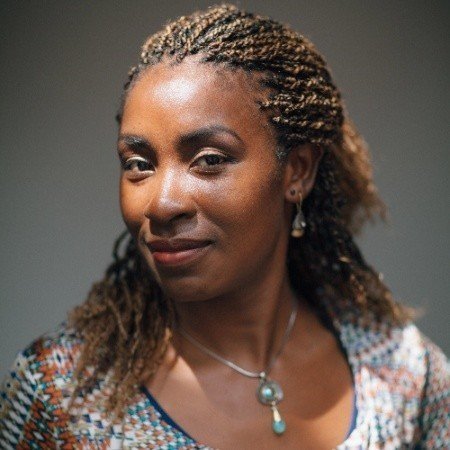From Invisibility to Radical Empathy
I am passionate about my work as a Product Inclusion Specialist, a profession where I build products that work for everybody, regardless of ability, gender, resources, culture, race, or class. I focus on building ethical products and processes that resist exploiting customers as merely transactional profit providers, because greed is the enemy of equal socioeconomic progress, and there is a middle: building equitably for both people and profits.
As technology has exploded around us and demonstrated capabilities beyond our imagination, we’ve come to believe that building machines will relieve us of our own biases and shortcomings. Machines, we believe, won’t be flawed the way we are. With those beliefs in mind, we build triage robots to complete patient intake. They’re made of metal, wires, and software, and thus can’t carry preconceived notions, so they can’t discriminate, right? In fact, machines are infused with our biases, because the healthcare providers who contribute to the education of these robots consistently rate pain with bias. The chilling reality is that we have seen time and again how race, age, and gender can all affect how your condition is assessed as well as the urgency with which you are treated. While these inventions are truly world-changing, we need to reckon with the fact that they have enabled us to offload the responsibility for fairness and the blame for unequal outcomes.
When I was six, my Black father and white adoptive mother moved my family from Togo, where I was born, to Ithaca, New York. It was in New York that I had one of my first experiences navigating the U.S. healthcare system.
My mother rushed me to the emergency room, my six-year-old self doubled over in another sickle cell crisis. We had assumed that healthcare would be, if not easy to figure out, at least simpler and more straightforward than in Togo, where many who suffer from sickle cell anemia have a low probability of living past childhood. The barrage of questions the nurse asked my mother was something we did not expect; looking to my mother the nurse asked:
“Does your daughter lie?”
“How do you know when your daughter is telling the truth?”
“Does your daughter exaggerate?”
“Are you sure this is not drug-seeking behavior?”
This kind of disbelief regarding patients’ symptoms happens to parents and children of color all the time and is nothing that my white mother could shield me from. The message being that Black pain is not believed. We are exaggerating or inventing our pain. Our need for care, often from a white provider, is minimized or rejected. Not even money can validate your being or hold back the medical-bias grim reaper, as seen with Serena Williams’ experience with an emergency C-section.
Dismantling these biases starts at the core, and so work in product inclusion involves confronting bias at the source. This typically starts with the team of developers and designers, some of whom have yet to examine their own status, privilege, biases, and lack of exposure to difference. Thus, they cannot as individuals imagine real users who live with various visible and invisible barriers, whose needs are unique to their geography, culture, gender, race, age, or physical limitations.
The white doctors who haven’t challenged the biases in medical learning or done any deep work in diversity, equity, and inclusion, can only see versions of themselves — white patients’ pain is real, white patients’ emergencies are urgent. Not so for a Black child or adult in agony. The same issues ring true for product designers who so often build technology for projected images of themselves. When we use their products, it feels like holding up a mirror and seeing the average CEO from Silicon Valley, the Mark Zuckerbergs or Steve Jobs, instead of ourselves. My work expands product designers’ awareness and imagination so they can actually build for the masses at scale.
“…greed is the enemy of equal socioeconomic progress, and there is a middle: building equitably for both people and profits.”
Living with an invisible disability is part of what brought me to this work. I can’t expect others to see my pain, but that pain has given me a new kind of vision. My disability makes me see a trash can sitting directly below our office elevator call buttons, making them inaccessible to anyone in a wheelchair. It makes me ask for more doors to be automated so more people can use them with independence and dignity. I don’t get treated like someone who has a perceivable difference in ability, but through my experience with the healthcare system I sympathize with others, and I can’t help but be honed-in to how others are treated.
I bristle when I hear the impaired spoken to by the able-bodied with a tone of concern mixed with condescension, fear, and palpable discomfort. My outrage is mixed with a small sense of relief that no one speaks to me that way because they can’t see my sickle cell anemia. When my disability becomes visible, when the pain coursing through my blood vessels is overwhelming, those same people wonder why I’m so standoffish, why I’m not smiling, why I’m making them uncomfortable.
No one should have to live in a world where you have to constantly minimize your pain or disability to make the status quo feel okay. Building inclusive products begins with being uncomfortable because you are sitting with difference. Inclusive design requires a radical empathy that allows you to see people fully — as they are, as different from you, as whole, as storied, as desiring and deserving of love. It also means that I show up fully in my own work — as a Black woman, an immigrant, an adoptee, and medically disabled, with everything you can and cannot see that makes up who I am.
It’s not a failure to admit we each have biases, and understanding that is crucial because we’re products of our cultures, environments and upbringing. Understanding this human fault brings awareness to how and where our biases are showing up. This self-awakening is part of the process of unlearning those biases and being intentional about not recreating them in perpetuity in our socio-political, governmental, technological, infrastructural (and other types of) systems.
I am grateful that my disability, even when it renders me and my pain invisible, instills in me the resolve to not let others go unseen or begging to be believed. I am grateful for how it has taught me to see, for whom it has allowed me to see with more humanity. Including myself.
Joy Buolamwini: How I’m Fighting Bias in Algorithms TEDTalk
Dr. Dede Testubayashi’s (Deh-deh Teh-tsu-bye-ya-she) expertise is DEI + product + business value and integrating them into a team and organization's best practices. She has extensive experience building frameworks and guidelines to integrate product inclusion into the development process, and driving adoption as an integral portion of phased and prioritized roadmaps for teams to execute against. Dede is a member of the Equity Army run by Annie Jean-Baptiste, a group focused on educating organizations on Product Inclusion. She's also a founding member of Tech Ladies, a group focused on inclusivity in tech, and is working on two new publications; a memoir and a product inclusion guide.


